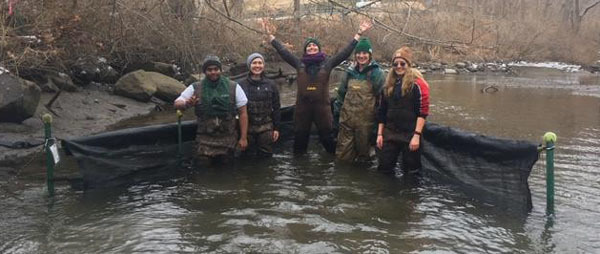Hudson River Almanac 3/2/19 - 3/8/19
The New York State Department of Environmental Conservation sent this bulletin on 03/15/2019 02:00 PM EDT |
| DEC Delivers - Information to keep you connected and informed from the NYS Department of Environmental Conservation |
| Share or view as a web page || Update preferences or unsubscribe |
Hudson River Almanac
|
Compiled by Tom Lake, Hudson River Estuary Program Consulting NaturalistOverviewThis week featured a mix of wintering birds slowly returning, including an early surprise, bald eagles getting serious with nesting, and a selection of owls in a variety of habitats. We also had a mystery regarding newts, and ask readers to consider what it was all about.Highlight of the Week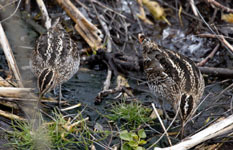 3/7– Pleasant Valley, HRM 77: I had a delightful, albeit totally unexpected, surprise today when two Wilson’s snipe appeared in my yard foraging in the underbrush. This shorebird breeds well to the north into the Arctic and winters along the coast and to the south of our watershed. In Dutchess County, Wilson’s snipe is seen primarily in migration and is uncommon in winter. (Photo of Wilson's snipe courtesy of Jamie Collins) 3/7– Pleasant Valley, HRM 77: I had a delightful, albeit totally unexpected, surprise today when two Wilson’s snipe appeared in my yard foraging in the underbrush. This shorebird breeds well to the north into the Arctic and winters along the coast and to the south of our watershed. In Dutchess County, Wilson’s snipe is seen primarily in migration and is uncommon in winter. (Photo of Wilson's snipe courtesy of Jamie Collins)- Jamie Collins (Ralph T. Waterman Bird Club) Natural History Entries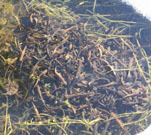 3/2 – Ulster County, HRM 110: We snowshoed today to a remote swamp in the town of Windham. In an open area along the shore, we came across an open pothole in the ice that was filled with hundreds of writhing eastern red-spotted newts. What an amazing sight! (Photo of red-spotted newts courtesy of Deb Berry) 3/2 – Ulster County, HRM 110: We snowshoed today to a remote swamp in the town of Windham. In an open area along the shore, we came across an open pothole in the ice that was filled with hundreds of writhing eastern red-spotted newts. What an amazing sight! (Photo of red-spotted newts courtesy of Deb Berry)- Deb Berry, Kevin Berry [Amphibian experts Al Breisch and Peter Ducey viewed photos of the “band” of red-spotted newts (Notophthalmus viridescens, var. N. v. viridescens). They concluded that neither had ever seen anything like it before. (Note: With no collective noun for newts, we used the collective noun for salamanders.) If any readers have seen this before, or have an idea of what was going on, please e-mail us. (trlake7@aol.com). Thank you. Tom Lake] 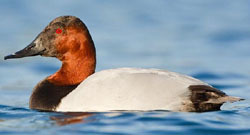 3/2 – Esopus Meadows, HRM 87: In mid-afternoon, I counted ten common goldeneye on the river near the Esopus Meadows Lighthouse. While they were very nice, they could not compare to the 37 canvasbacks we saw there as well! (Photo of canvasback courtesy of Steve Metildi) 3/2 – Esopus Meadows, HRM 87: In mid-afternoon, I counted ten common goldeneye on the river near the Esopus Meadows Lighthouse. While they were very nice, they could not compare to the 37 canvasbacks we saw there as well! (Photo of canvasback courtesy of Steve Metildi)- Barbara Mansell (Ralph T. Waterman Bird Club) 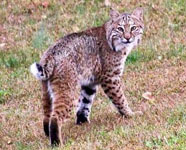 3/2 – Millbrook, HRM 82: My trail cameras have picked up a bobcat only once in the last several years, but in the past week, one of the cameras recorded eight bobcat videos, with at least one on five of the seven days. Seven of the videos were between 5:30 and 11:30 AM, and another at 3:30 PM. In each instance, the bobcat was walking east to west along the south edge of a field. In one of the videos, the bobcat looked quite trim; in the others it looked heavier. My guess is that a pregnant female (the heavy bobcat) had moved in nearby and to the east of my cameras, and the father (the trim one) was lingering in the neighborhood. I’m looking forward to videos of the kittens in the springtime. (Photo of bobcat courtesy of Deborah Tracy-Kral) 3/2 – Millbrook, HRM 82: My trail cameras have picked up a bobcat only once in the last several years, but in the past week, one of the cameras recorded eight bobcat videos, with at least one on five of the seven days. Seven of the videos were between 5:30 and 11:30 AM, and another at 3:30 PM. In each instance, the bobcat was walking east to west along the south edge of a field. In one of the videos, the bobcat looked quite trim; in the others it looked heavier. My guess is that a pregnant female (the heavy bobcat) had moved in nearby and to the east of my cameras, and the father (the trim one) was lingering in the neighborhood. I’m looking forward to videos of the kittens in the springtime. (Photo of bobcat courtesy of Deborah Tracy-Kral)- Nelson D. Johnson 3/2 – Rockland County, HRM 33: In the last few days, bald eagle nest NY336 in Conger has always had at least one adult in the vicinity, if not actually in the nest at all times. Today, I watched the nest for a while and could not discern any eagles at all. Then, in early evening, a dark shape appeared from the depths of the nest. As the shape moved, I could see that it was one of the adults that had been hidden from view. The bird moved up and around the nest, apparently adjusting something, perhaps moving eggs, and then settled back down out of sight in the nest. - Chris Galligan 3/3 – Washington County, HRM 209: I headed over to the Washington County Grasslands today, after getting more reports of pine grosbeaks in Salem. I first visited a group of long-eared owls on Blackhouse Road and found three roosting deep in a hedgerow. I hiked in the snow and ice (with crampons) to the observation deck at the end of the trail on Blackhouse Road, encountering two rough-legged hawks on the way, one light-phase and one dark. While looking southeast from the observation deck, I found two northern shrikes perched at the top of different branches on the same tree. A short-eared owl was also visible on a great day of birding. - Scott Varney (Hudson-Mohawk Bird Club) [The reports for the Hudson River Almanac of all female flocks of pine grosbeaks should be tempered a bit since immature males are usually indistinguishable from the females under usual field conditions of observation. The really interesting question is, where are the adult males? I have had pine grosbeaks in Williston, Vermont, more or less all winter, and on first glance, all seem to be females, but I must admit, I should go back and look more carefully to make sure. Don Miller] 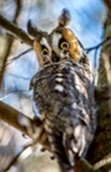 3/3 – Fort Edward, HRM 202: We had a brief visit to the Fort Edward Grasslands where we spotted three long-eared owls (a life bird for Denise). Other birds included a short-eared owl, two red-tailed hawks, and three light-morph rough-legged hawks. (Photo of long-eared owl courtesy of Joe Gliozzo) 3/3 – Fort Edward, HRM 202: We had a brief visit to the Fort Edward Grasslands where we spotted three long-eared owls (a life bird for Denise). Other birds included a short-eared owl, two red-tailed hawks, and three light-morph rough-legged hawks. (Photo of long-eared owl courtesy of Joe Gliozzo)- Scott Stoner, Denise Hackert-Stoner (Hudson-Mohawk Bird Club) 3/3 – Bergen County, NJ, HRM 13-14: Six members of the Hackensack River Canoe and Kayak Club did a hike along the Shore Trail in the Palisades Interstate Park from Englewood Boat Basin to Lambier's Dock, below Greenbrook Sanctuary. The river, at low tide, was as smooth as a pond. Along the way we spotted three American black ducks close to shore and then a pair of hooded mergansers drifting off the ruins of an old structure known as Powder Dock. We shared the observations and our binoculars with passing hikers and most got good looks at the waterfowl. Then the ducks disappeared; they just seemed to vanish. - Bob Rancan, Melody Wenger, Mike Capizzi, Ritz Matsusuki 3/4 – Wappinger Creek, HRM 67.5: We traipsed through seven inches of new snow that was just a little short of snowshoe depth for us. The trees along the 1.6-mile tidewater reach were decorated in white. Two adult bald eagles were perched in the top of hardwoods, well up off the water and with a good view. It was high tide and not the most opportune time for hunting. As the tide dropped, the water would become shallower, and the eagles would find that fish were much easier to find and catch. - Tom Lake, B.J Jackson 3/4 – Rockland County, HRM 33: While at my daily post in early evening watching bald eagle nest NY336, I spotted some very brief and quick movement. An adult eagle arrived and settled to roost very close to the nest. The other adult may have been down in the nest, but my view was limited. Taken in total, these were very optimistic nesting signs. - Chris Galligan 3/5 – Warren County, HRM 245: I drove along the Hudson River south of The Glen this morning. The Ice Meadows had regained some of its “glacial” form and was again, after a brief thaw, looking more impressive. There were five-foot-high walls of ice on the river with just a few visibly open channels. - Mike Corey [Evelyn Greene explains that the Ice Meadows are a natural grassland that is presumably made possible by ice and water scouring the river’s cobbles and edges, killing or at least flattening shrubs and trees. This results in the ground being open to the sun all summer, unlike in the nearby forest, allowing a wide variety of plants to grow in different habitats. These habitats include cool and moist areas of late-lasting ice banks, hot and dry gravel and cobbles, acidic, seepy areas, calcareous wet and dry places, and crevices in acidic and calcareous ledges. The north-facing undercut banks often cling to their ice well into spring. Naturalist James Briggs related a story to me from 25 years ago, when the last fist-sized piece of ice, almost like permafrost, melted on Memorial Day (May 30). Tom Lake] 3/5 – Norrie Point, HRM 85: I was just treated to a bald eagle ballet. Recent brutally-cold nights had added a layer of thin ice along the river shoreline, but the ice was being challenged by a rising tide. An adult eagle, possibly one from local nest NY142, was standing on the ice. However, after a few seconds the eagle and the ice began to sink. Once its leg feathers started to get wet, the bird would half-fly, half-dance over to new ice a few feet away. Then the whole scenario would repeat itself. After ten minutes, the eagle gave up and flew away toward the mouth of the Indian Kill. - Chris Bowser 3/5 – Manhattan, HRM 1: We checked our research sampling gear in Hudson River Park at The River Project's sampling station on the lighthouse tender Lilac at Pier 25. The water was absolutely frigid, but we still collected a handful of shore shrimp, isopods, some very large amphipods, and a couple of handsome mud crabs to begin stocking our River Project tanks on Pier 40 for the upcoming education season. -Siddhartha Hayes 3/6 – Saratoga County, HRM 177.5 After encountering a general absence of birds on our trip, we drove to Galway Nature Preserve and stopped when we saw a lot of birds flying around. We spotted and then heard two “cold” red-winged blackbirds, our first of the year. The 14 bird species we counted included a common raven (heard calling), four American tree sparrows, and four northern cardinals (2 pairs). - Ron Harrower (Hudson-Mohawk Bird Club)  3/6 – Albany-Columbia counties: There are a lot of barred owls out there these days. Yes, days – sights not common for this nocturnal bird. It seems there has been an "incursion" of the species this winter for reasons variously unknown or not well understood. Watch for them, perched quietly in the openings of woods or by roadsides. Unfortunately, many are venturing out onto the roadways and getting hit by cars. Watch for them. (Photo of barred owl courtesy of Steve Roberts) 3/6 – Albany-Columbia counties: There are a lot of barred owls out there these days. Yes, days – sights not common for this nocturnal bird. It seems there has been an "incursion" of the species this winter for reasons variously unknown or not well understood. Watch for them, perched quietly in the openings of woods or by roadsides. Unfortunately, many are venturing out onto the roadways and getting hit by cars. Watch for them. (Photo of barred owl courtesy of Steve Roberts)- Rich Guthrie 3/7 – Minerva, HRM 284: We have yet to see or hear any red-winged blackbirds in the approaches to the High Peaks of the Adirondacks. It has been Arctic-like cold. Our maple sap-syrup season (“sugarbush”) has likewise been stalled. - Mike Corey 3/7 – Saratoga County, HRM 170: I stopped by Blockhouse Museum Park this morning to see what was happening out on the river. I immediately spotted a single snow goose cruising down the shore like it was being pulled on a string. The dozen bird species I counted also included Canada geese (210), Common goldeneye (34), and an adult bald eagle. - Ron Harrower (Hudson-Mohawk Bird Club) 3/7– Saratoga County, HRM 166: I stopped at the Historical Mill at Lock 2 near Mechanicville just after midday and looked out over the shallows for waterfowl. The highlights of seven species were two pairs of pintails and a male American wigeon. I love this time of the year when the true first migrants are working their way north. - Ron Harrower (Hudson-Mohawk Bird Club) 3/7– Town of Wappinger, HRM 67: It is not unusual to watch and wait as a flock or a family of wild turkeys crosses a road, usually with “crossing guards” fore and aft. This morning, we encountered a twist on the usual when we hitched onto the back of a long line of wild turkeys (we counted 31) walking directly up the middle of the road. They had come out of the woods, where they had stayed the night, and were heading to a house at least six blocks away where cracked corn is put out. We fully enjoyed the five minutes of having our hectic life shifted into neutral. - Tom Lake, B.J. Jackson 3/8 – Town of Wappinger, HRM 67.5: On May 15, 2018, a micro-burst with 95 mile-per-hour winds destroyed bald eagle nest NY459 at the mouth of the tidewater Wappinger Creek. Two nestlings were tossed to the ground from 100 feet but survived and were successfully treated by wildlife rehabilitators. The adult pair, resilient as bald eagles tend to be, began rebuilding the nest on June 26, witnessed by a small devoted group of nest watchers, including Dana Layton, Sheila Bogart, John Devitt, and Mauricette Char Potthast. This morning, it was low tide not long after sunrise. The sun’s warmth would not reach the north-facing NY 459 nest, situated in the lee of a hillside, for at least another half-hour. One adult was hunkered down in the nest, apparently incubating eggs. The other was perched on a whippy branch over the creek prospecting for a meal in the lightly iced-over shallows below. - Tom Lake, T.R. Jackson *** Fish of the Week *** With winter here and much of the watershed’s ponds, creeks, lakes, and rivers iced-over, many of us are going through fish withdrawal. As a coping device, until fully open water returns in March, we will have a “Fish of the Week” feature.  3/8 – Hudson River Watershed: This week’s fish is the redfin pickerel (Esox americanus americanus) species number 83 (of 228) on our watershed list of fishes. (If you would like a copy of our list, e-mail: trlake7@aol.com.) 3/8 – Hudson River Watershed: This week’s fish is the redfin pickerel (Esox americanus americanus) species number 83 (of 228) on our watershed list of fishes. (If you would like a copy of our list, e-mail: trlake7@aol.com.)Redfin pickerel is a native species that is less well-known than other members of the pike family (Esocidae). Others include northern pike (E. lucius), chain pickerel (E. niger), and the tiger muskellunge, a pike-muskellunge hybrid (E. lucius x E. masquinongy). Redfin pickerel is a rather small fish (rarely exceeding a foot-long) that is most often found in shallow, weedy areas of the watershed. C. Lavett Smith describes them as having a long, arrow-shaped body, long broad snout, and jaws with prominent canine-like teeth, marking them as a high-end predator in its chosen niche. (Photo of redfin pickerel courtesy of Aidan Mabey) Tom Lake 3/8 – Queens, New York City: There are precious few silver linings to the incessant traffic along the Belt Parkway, but it is interesting to note the amount of wildlife to which the road bears an unwitting witness. Stuck smack dab in the middle of a traffic jam just north of the new Shirley Chisholm State Park, my eye caught site of a disturbance along the boundary fence. There, an obviously agitated sharp shinned hawk was dive-bombing and otherwise harassing, a red-tailed hawk. For a full minute, I made a study of their radically different flight styles. Then, the red-tail simply moved on through and seemed to take great pains in letting the far smaller sharp-shinned know that it wasn't feeling particularly “harassed” by all the fuss. - Dave Taft
|

